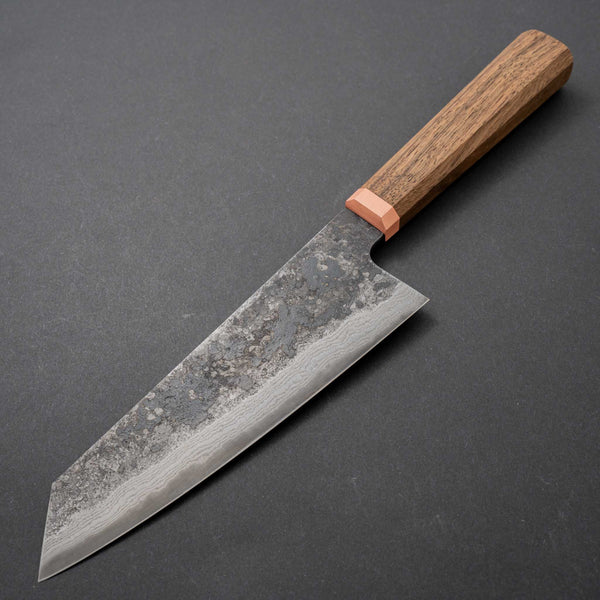Blenheim Classic Santoku 175mm
Low stock
Blenheim Forge er et lille værksted i udkanten af London, hvor James, Jon og Rich laver fantastiske knive fra bunden, helt fra den rå smedning til den færdige skæftning.
Knivene har et råt og rustikt udtryk, men der er samtidigt kælet for detaljerne med afrundet hæl, tynde taperede klinger og lækre afslutninger på skæftet.
Knivene udkommer i to standard serier "classic range" og "stainless clad". Begge serier er smedet af japansk carbonstål fra Takefu Steel Mill i Echizen Japan.
Classic Range:
"Fuld carbon klinge med damasceret jerncladding og kerne af blå 2 (aogami 2). Serien udmærker sig ved en super skarphed og ved at være nemme at slibe op.
Skæftet er bygget op af engelsk valnød og ferrule af kobber."
Stainless Clad:
"Klingen er opbygget med et rustfrit ydrelag og en kerne af blå super (aogami super). en opbygning som giver det bedste fra to verdener. Det rustfrie ydrelag gør vedligehold nemmere og den hårde kerne af Blå super, som er nem at slibe og giver en skarphed som holder forrygende længe.
Skæftet er bygget op af Røget engelsk egetræ og ferrule af messing."
Begge serier ikke rustfri, hvorfor ekstra pleje og omhu skal forventes og det anbefales derfor at kniven vaskes og tørres direkte efter brug.
Stålet udvikler patina over tid, og bladet vil få en mat og mørkere fremtoning.
Som alle knive, tåler denne specielt ikke opvaskemaskine.
Knivene kan ses og prøves i butikken.
Specs
Brand: Blenheim Forge
Profile: Santoku
Size: 175mm
Steel Type: Carbon Steel
Steel: Blue (Aogami) #2, Carbon Damascus Clad
Handle: English Walnut & Copper Ferrule Octagonal
Total Length: 310mm
Blade Length: 175mm
Blade Height: 55mm
Thickness: 3mm at handle
Handle Length: 130mm
Weight: 170g
Maintenance & Care
CARE AND MAINTENANCE:
NEVER PUT YOUR KNIVES IN THE DISHWASHER! That's it, and it applies to all knives. There are far too many chemical processes and changing heat effects for it to be good for anything made of steel. Most stock material cannot withstand it either.
You can roughly divide knives into two categories when we talk about care and maintenance; carbon knives (carbon knives) and stainless/semi stainless knives.
Carbon steel can be sharpened insanely sharp and holds an egg well (edge retention), but can rust and patina. Stainless steel has the advantage of being less prone to rust, but is not quite as sharp. Roughly speaking, because there are gradually many stainless "super steels" that have close to the same properties as carbon steel.
USE
Pay attention to how hard the knife is hardened. Be especially careful with knives of 60 hrc and above. Hard foods can "chip" the blade. Be careful with fruit stones, bones, shellfish, woody stems or very hard cheese. Frozen foods are a total no-go.
Your cutting board plays a big role. Use wood. Endwood is particularly good. Plastic can also be fine, but definitely not glass, granite or bamboo. Hinogi (cypress) is particularly good and otherwise there are from the very top shelf, rubber cutting boards with wooden handles.
Scraping the edge of the knife sideways will dull or damage your knife. Instead, use the back of the knife to move items across the cutting board. Do not twist the edge or pry the tip and for the record, your knife is NOT a screwdriver!
CLEANING
After use, wash the knife by hand with ordinary washing-up liquid, rinse with warm water and dry immediately. No dishwasher! Highly reactive steel, such as white #1, can be advantageously wiped off regularly during use. These types of steel can benefit from a little oil on the steel from time to time.
Wooden handles can dry out over time and exposure to water. Simply treat them with some food-safe mineral oil or beeswax. Can possibly lightly sanded with sandpaper before and after.
STORAGE
Take care of the egg, for your own sake and the sake of the knife. A saya (sheath) is optimal, but a simple blade cover will be fine if you store knives in a drawer or travel bag. Loosely lying in a drawer is a super bad solution.
A wall magnet made of wood is a great way to display your knives. Be sure to put it back on the spine first, then roll it on the surface of the blade. This will prevent the egg from making contact with the tree first. Steel knife magnets are a bad idea as they will scratch the blade of the knife.
Knife blocks are not optimal, neither for the egg nor for hygiene.
MAINTENANCE
All knives should be straightened before each use. This is best done on a leather strap. Steel irons are unsuitable for knives with a hardness of 59 and above. A ceramic version can be used here, but you have to be aware that it will grind and remove steel every time you use it. It is not appropriate if the egg simply needs to be "raised". We can help with leather straps and their use.
When the knife gradually becomes so dull that a definite sharpening is unavoidable, this is best done on a wet stone or a slow-moving sharpening machine. If you don't have the skills or the courage, drop it off with us and we'll take care of it.









